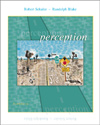| absolute threshold | The minimum stimulus intensity that a person can detect. See difference threshold.
|
 |
 |
 |
| beta (b) | In sensory decision theory, a measure of the observer's bias.
|
 |
 |
 |
| criterion | The implicit rule used by an observer in order to convert sensory information into overt responses.
|
 |
 |
 |
| cross-modality matching | A psychophysical procedure in which one sort of stimulus (for instance, a light) is adjusted so that the sensation the stimulus produces matches the sensation produced by a different sort of stimulus (for instance, a sound).
|
 |
 |
 |
| d' | In sensory decision theory, a measure of sensitivity.
|
 |
 |
 |
| dark light | See intrinsic light.
|
 |
 |
 |
| difference threshold | The minimum amount by which stimulus intensity must be changed in order to produce a just noticeable change in sensation. See absolute threshold.
|
 |
 |
 |
| direct scaling techniques | A set of psychophysical procedures for measuring subjective sensory experiences such as loudness or brightness; these procedures are based on the assumption that people can rate sensory magnitude.
|
 |
 |
 |
| forced-choice method | A psychophysical procedure in which a person must identify the interval during which a stimulus occurred; in an alternative version, the person must identify the spatial location at which a stimulus was presented.
|
 |
 |
 |
| intrinsic light (dark light) | The impression, in complete darkness, of a dim cloud of light.
|
 |
 |
 |
| method of adjustment | A psychophysical procedure in which a person adjusts a stimulus so that it is just detectable (absolute threshold) or until a just noticeable change is produced (difference threshold).
|
 |
 |
 |
| method of constant stimuli | A psychophysical procedure in which each of a fixed set of stimuli is presented in random order.
|
 |
 |
 |
| method of limits | A psychophysical procedure in which the stimulus intensity changes progressively in small steps until the person's response changes, for example, from "No, I don't see it" to "Yes, I do see it."
|
 |
 |
 |
| multidimensional scaling (MDS) | A quantitative technique for geometrically representing similarity among stimuli.
|
 |
 |
 |
| power law | The psychophysical principle that sensation magnitude tends to grow as a power function of stimulus intensity.
|
 |
 |
 |
| psychophysics | The branch of perception that is concerned with establishing quantitative relations between physical stimulation and perceptual events.
|
 |
 |
 |
| psychometric function | A graph showing the frequency with which each stimulus elicits each of two possible responses.
|
 |
 |
 |
| psychophysical function | A graph showing the threshold as a function of some stimulus variable.
|
 |
 |
 |
| sensory decision theory (SDT) | A quantitative treatment of detection and discrimination performance, in which the observer is characterized as a maker of statistical decisions; the system also prescribes techniques that allow the observer's sensitivity to the stimulus to be estimated independently of the observer's criterion, or preference for particular responses. Also called signal detection theory.
|
 |
 |
 |
| signal detection theory | See sensory decision theory.?
|
 |
 |
 |
| staircase method | A psychophysical procedure in which the stimulus presentations, governed by a person's responses, are made to bracket the threshold; an interactive variant of the method of limits.
|
 |
 |
 |
| Weber's Law | The principle that for various stimulus intensities the difference threshold tends to be a constant fraction of the stimulus.
|



 2002 McGraw-Hill Higher Education
2002 McGraw-Hill Higher Education

 2002 McGraw-Hill Higher Education
2002 McGraw-Hill Higher Education